Abstract
The results of full-scale acoustic tests of a Ptero-G0 unmanned aerial vehicle (UAV) in an anechoic chamber are presented. The aim of the work is to determine the acoustic characteristics of a Ptero-G0 UAV and to assess the influence of various parameters on the noise level of the device. A unique aspect of the experiment is that a full-scale apparatus with a power plant including a single-cylinder 4-stroke piston engine and 2-bladed fixed-pitch propeller, was studied. Data on the spectral, energy and directivity characteristics of the UAV and its power plant were obtained. The tests assessed the effects of incoming flow velocity, power condition of the power plant, pitch angle of the UAV, propeller diameter, and vibrations of the bonnet on the UAV noise. In particular, increase in the power condition (engine speed) and incoming flow velocity led to an increase in spectral noise levels in the 1/3-octave frequencies bands ranging from 40 to 10,000 Hz. At the same time, background levels up to 40 Hz were determined by background noise. The influence of engine speed and incoming flow velocity on the directivity pattern has not been established. An increase in propeller diameter at a constant speed resulted in higher circumferential speed of the propeller and thrust, as well as increased load on the engine. As a result, intensity of the tonal components of propeller and engine noise increases. A slight decrease in diameter (by 6 %) led to a decrease in the overall noise level by 1.3 dB. Placing the engine in the bonnet without a vibration insulation system led to an increase in the overall sound pressure levels by up to 2.5 dB.
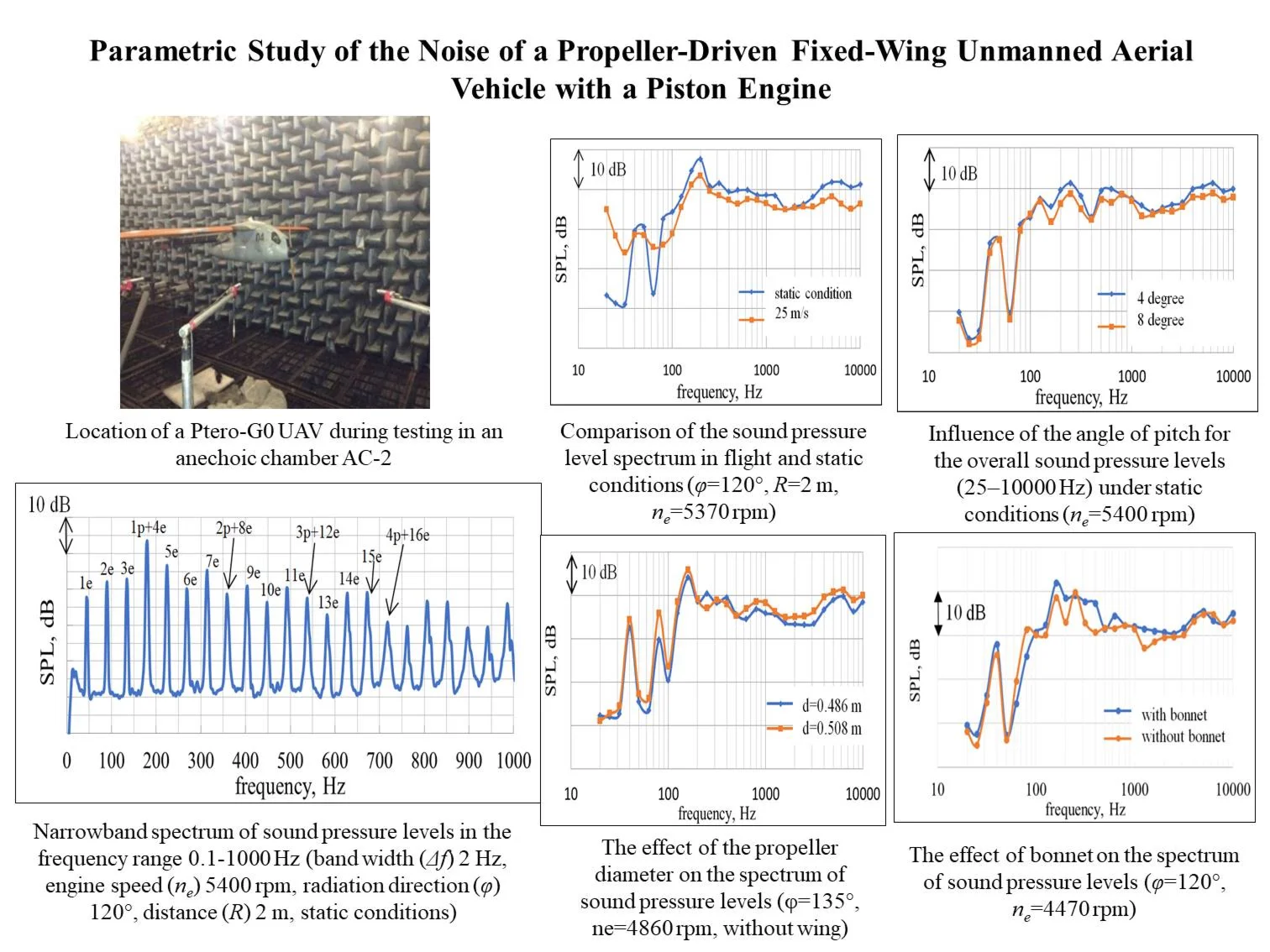
Highlights
- The results of full-scale acoustic tests of a Ptero-G0 unmanned aerial vehicle (UAV) in an anechoic chamber are presented.
- The aim of the work is to determine the acoustic characteristics of a Ptero-G0 UAV and to assess the influence of various parameters on the noise level of the device.
- The dominant source of PP noise is an internal combustion engine with a low-efficiency exhaust muffler.
- Under static conditions, an increase in the angle of pitch of UAV from 4 to 8° leads to a decrease in the overall sound pressure level by up to 2 dB in the direction of 60°.
- A slight decrease in diameter (by 6%) led to a decrease in the total noise level by 1.3 dB in the entire studied range of azimuth angles without an effect on the nature of directivity pattern.
- The presented results can be used to validate computational methods for estimating the noise of a propeller and a piston engine.
1. Introduction
Currently, the theme of drones is becoming increasingly relevant. The low noise of unmanned aerial vehicles (UAVs) offers a competitive advantage for civilian applications and serves as an indicator of survivability for military vehicles.
The structure of the problem of UAV acoustics is considered in Fig. 1. For special-purpose UAVs, it is crucial to ensure the inaudibility [2] and invisibility while simultaneously being able to detect, identify and determine the flight path of enemy UAVs in real time (target direction finding). The solution to this problem is possible both with the help of specialized ground equipment and specialized UAVs with microphone arrays performing airspace patrol [3-5].
When designing civil aircraft, it is necessary to ensure competitive community noise levels. To achieve this at various stages of the device's creation, estimates of the UAV’s community noise levels are performed using specialized software [6-10] which analyzes the superposition of the noise fields of the main sources (propeller [11, 12], engine [13-15] and airframe [16-18]), taking into account actual aircraft configurations and various noise reduction methods for both discrete sources and methods of leveling aeroacoustics effects in real configurations [19-21].
Within the framework of aeroacoustics of propeller-driven UAVs, the main areas of research are:
– Study of the spectral and integral characteristics of ambient noise and its masking effect on an observer and measuring systems [22].
– Experimental study of the sound field structure of various types of UAVs, including separately propeller noise and engine noise, noise of airframe elements and aeroacoustics effects in real aircraft configurations.
– Research and selection of criteria for audibility and acoustic signature of various types of propeller-driven UAVs.
– Study and development of noise reduction methods for propeller UAVs.
Fig. 1The structure of the UAV aeroacoustics problem

The ultimate goal of research in UAV aeroacoustics is to develop the following calculation methods and software necessary for implementing the concept of acoustic design for propeller-driven UAVs [23]:
– A method for calculating ambient noise in various area landscapes at different wind speeds and types of underlying surfaces.
– A method for modelling propeller-driven UAV noise, taking into account main sources and aeroacoustics effects in real aircraft configurations.
– Software for assessing UAV community noise, considering the Doppler effect, sound absorption in a real turbulent atmosphere and near the earth's surface, interference from direct and reflected sound near the earth's surface.
– Software for detecting, identifying and determining the flight path of a propeller-driven UAV in real time.
– Software for constructing spatiotemporal trajectories of UAV movement that are undetectable by ear or through acoustic direction-finding devices.
In contrast to results of many studies devoted to computational [24-32] and experimental [33-40] studies of UAV noise, this paper considers a real Ptero-G0 UAV that is commercially available and operational, rather than separated isolated propellers, piston engines, or electric motors. This work continues the authors' research into the sound fields of propeller-driven fixed-wing aircrafts [41-51].
The aim of this work is to determine the influence of various parameters on the noise levels of fixed-wing UAVs. Within the framework of these parametric tests, it was possible to evaluate the effects of incoming flow velocity, power condition of the power plant (PP), UAV pitch angle, propeller diameter, and vibrations of the bonnet on community noise levels.
Based on the results of this study, a database of acoustic characteristics for the device has been formed, which can be used to validate computational methods for estimating noise of a propeller and a piston engine.
The presented results can assist developers in designing similar devices taking into account the required acoustic parameters and, in addition, allow to evaluate the acoustic signature and audibility characteristics of a Ptero-G0 UAV using special software.
2. Object of the study and the method of acoustic tests
A study was conducted on the acoustic characteristics of a Ptero-G0 UAV, developed by AFM-Servers LLC, was carried out in an anechoic chamber AC-2 [52]. The general view of the UAV during testing is shown in Fig. 2. The maximum take-off weight of the UAV is 20 kg. The UAV's power plant includes a single-cylinder, four-stroke Saito FG-40 engine with a maximum power of 2.9 kW and a 2-bladed fixed pitch propeller.
AC-2 is an anechoic installation with an open working circuit for studying the noise of turbulent jets, airframe noise, noise of small-sized propellers, etc. The flow enters an anechoic chamber with dimensions of 9.6 m×5.5 m×4.0 m. The walls of anechoic chamber are lined with acoustic polyurethane wedges, ensuring that deviations from free-field conditions do not exceed 1dB within the operating frequency band of 160-20000 Hz for sound waves with an intensity of no more than 160 dB.
Measurement points were located at the crankshaft axis level on a circle with a radius of 2 m. The measurement range corresponded to azimuthal angles from 30 to 135° with a step of 15° relative to the axis of the engine crankshaft (Fig. 3). Note that the nozzle diameter for creating the incoming flow is limited by the installation capabilities to 80 cm; therefore, the wing flow was carried out only in wings’ areas adjacent to the fuselage.
Fig. 2Location of a Ptero-G0 UAV during testing in an anechoic chamber AC-2
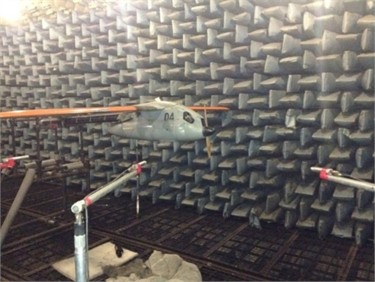
For measurements, we used half-inch microphones (type 4189) with preamplifiers (type 2669) from Bruel&Kjaer (frequency range 6.3-20000 Hz, sensitivity 50 mV/Pa). Before the start of the experiment, all measuring channels were calibrated using a pistonphone (type 4228) from Bruel&Kjaer. Signals from eight microphones were transmitted to the PULSE from Bruel&Kjaer multichannel data acquisition and processing system. This measurement system has a measurement error of ±0.5 dB for sound pressure level.
Processing of the measured audio signal included obtaining narrow-band spectra with a bandwidth of 2 Hz in the frequency range 0-12800 Hz and a 1/3-octave spectrum of sound pressure levels in the central frequency range 20-12500 Hz.
Acoustic tests were performed both in the presence of an incoming flow and without it (static conditions). The range of flow velocities corresponded to the range of UAV flight speeds from 20 to 35 m/s in increments of 5 m/s. The engine (propeller) speed () varied from 4800 to 6900 rpm. Propellers of various diameters (0.486 and 0.508 m), but of the same profile, were studied. A smaller diameter propeller was obtained by simply cutting the end of a wooden propeller.
Under static conditions, UAV noise measurements were performed with and without a bonnet, as well as with and without the wing, at different pitch angles of 4° and 8°. It should be noted that the total volume of acoustic measurements corresponded to 108 modes of joint operation for the power plant and the anechoic chamber.
Fig. 3Scheme of the location of noise measurement points on a circle with a radius of 2 m in AC-2 (the distance from the nozzle exit to the plane of rotation of the propeller is 1.7 m, the nozzle diameter is 0.8 m)
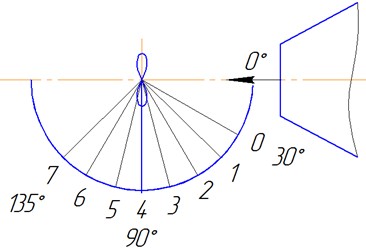
3. Main results of acoustic tests
3.1. Spectral characteristics of the acoustic field
The preliminary test results were discussed in Ref. [43]. A typical narrowband spectrum of sound pressure levels (SPL) measured during operation of the UAV power plant under static conditions is shown in Fig. 4. On the graph, the numbers with the indices “e” and “p” indicate tones at frequencies that are multiples of the frequency of the flashes in the engine cylinder and tones at frequencies that are multiples of the frequency of the propeller blades. It can be seen that the frequency of the 4th tone of the engine noise and the 1st tone of the propeller, as well as the 8th tone of the engine noise and the 2nd tone of the propeller, coincide, etc. In the further analysis of engine noise, only tones that are guaranteed to relate to engine radiation will be used, since it is not possible to separate these sources at the same frequency without conducting additional research. At the same time, we will assume that in the radiation spectrum at the frequency of the 1st tone of the propeller noise and the 4th tone of the engine noise, the intensity of the radiation from the propeller is dominant.
3.2. Influence of the power plant power condition and the incoming flow velocity
The effect of the engine speed on the direction of the total noise radiation at a constant velocity of the incoming flow is considered in Fig. 5. It can be seen that an increase in the operating mode leads to an increase in the overall sound pressure levels (OASPL) throughout the studied range of azimuth angles.
Fig. 4Narrowband spectrum of sound pressure levels in the frequency range 0.1-1000 Hz (band width (Δf) 2 Hz, engine speed (ne) 5400 rpm, radiation direction (φ) 120°, distance (R) 2 m, static conditions)
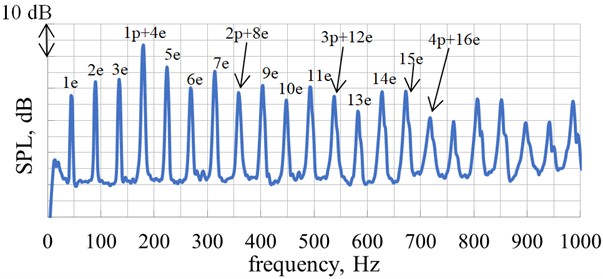
Fig. 5Influence of the incoming flow velocity on the direction of the total noise radiation (25-10000 Hz) of the PP (incoming flow velocity (V) 30 m/s, R= 2 m, configuration – without wing, with bonnet)
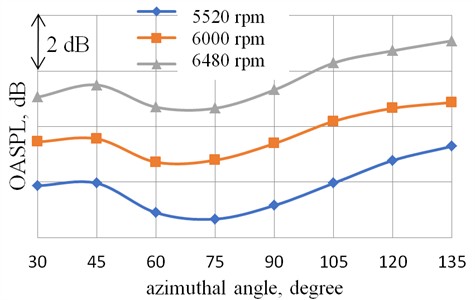
Fig. 6Influence of the PP power conditions on the narrowband spectrum of sound pressure levels (V= 30 m/s, φ= 120°, R= 2 m, configuration - without wing, with bonnet)
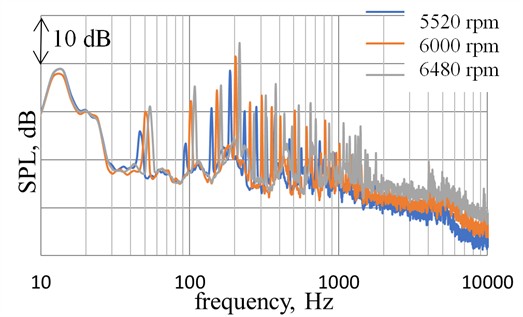
The narrowband spectra of sound pressure levels measured in the direction () of 120° are shown in Fig. 6. An increase in the power condition of the PP is found to lead to an increase in spectral levels in the frequency range of 40-10000 Hz due to an increase in the levels of the tonal components of propeller and engine noise, as well as broadband noise at frequencies above 2000 Hz. It is also possible to see the shift of characteristic frequencies in the radiation spectra with an increase in the power condition. Spectral levels in the range of 10-40 Hz (below the frequency of the first tone in the spectrum) do not depend on the engine speed, which indicates their connection with the background noise of the incoming flow.
The effect of the incoming flow velocity at a constant engine speed on the directivity pattern of the total noise radiation is considered in Fig. 7. An increase in the velocity of the incoming flow at a constant engine speed leads to an increase in the characteristic flow velocity of the blade profile and the load on the engine, and, as a consequence, to an increase in spectral levels in the frequency range of 40-10000 Hz (Fig. 8). An increase in spectral levels in the frequency range of 20-40 Hz is associated with an increase in the background noise of the incoming flow.
Fig. 7The effect of the incoming flow velocity on the direction of the total noise radiation (25-10000 Hz) of the PP (ne= 5520 rpm, configuration – without wings, with hood)
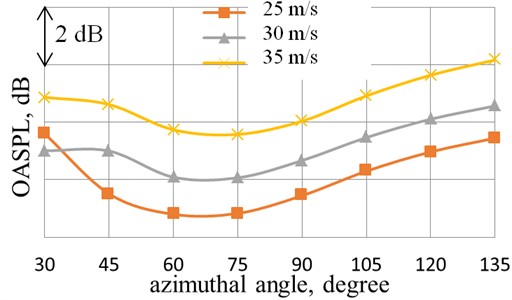
Fig. 8Influence of the incoming flow velocity on the 1/3-octave spectrum of sound pressure levels (ne= 5520 rpm, φ= 120°, configuration – without wing, with bonnet)
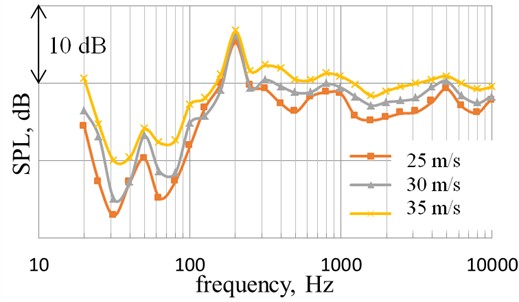
3.3. The effect of in-flight conditions
The effect of in-flight conditions on the directivity pattern of the overall noise of the UAV is considered in Fig. 9. The graph shows a comparison of the data obtained during the operation of the UAV power plant under static conditions and in the presence of an incoming flow of 25 m/s at the same engine speed (5370 rpm). It can be seen that the radiation patterns of the total noise radiation differ significantly when the PP is operating under static and in-flight conditions. Under static conditions, the overall sound pressure levels are higher in the entire studied frequency range by up to 3.4 dB in the direction of 105°.
The effect of flight conditions on the spectrum of sound pressure levels in the 1/3-octave frequency bands is considered in Fig. 10 for the radiation direction of 120°. It can be seen that in the presence of an incoming flow, the amplitudes of the tonal components in the noise spectrum decrease significantly. The greatest effect is observed at the frequency of the second engine tone (the 2nd tone in the spectrum). Note that in the presence of a flow, the levels of background broadband noise increase significantly, which indicates their connection with the background noise of the flow.
The results obtained can be interpreted as follows. When the propeller is operating under static conditions, maximum thrust develops, but the traction power is zero. In addition, in flight conditions, the turbulence scale of the flow impinging on the propeller disk is significantly lower than in static conditions. Thus, the role of noise from unsteady load on the propeller blades is significantly lower in flight conditions. In flight and static conditions, despite the equality of rotational speeds, the piston engine operates according to various partially high-speed characteristics. In the presence of an incoming flow, the engine is less loaded, which leads to a decrease in the intensity of the tonal components of its radiation.
The experimental data presented in Fig. 9 and 10 on the effect of in-flight conditions on the noise of a propeller-driven power plant are fully consistent with previously performed in-flight and static tests of power plants of light propeller-driven aircrafts [12, 47].
Fig. 9Comparison of the directivity pattern of the PP overall noise (25-10000 Hz) in flight and static conditions (R= 2 m, ne= 5370 rpm)

Fig. 10Comparison of the sound pressure level spectrum in flight and static conditions (φ= 120°, R= 2 m, ne= 5370 rpm)
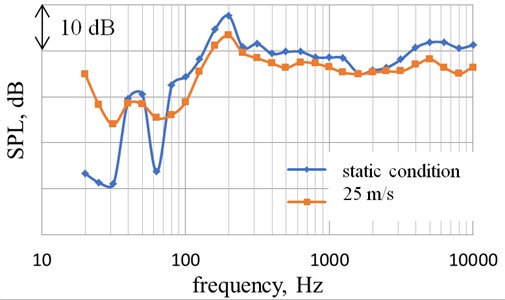
3.4. Influence of the pitch angle of the UAV
Based on the calculations obtained by the Hanson method [53] and presented in the Ref. [54], it is known that with a positive pitch angle (during takeoff) of the UAV, noise levels increase relative to the level-flight condition at the same propeller speed. Moreover, the higher the pitch angle, the higher the noise level of the propeller. With a negative pitch (with a decrease) of the UAV, there is a decrease in noise levels with an increase in the pitch angle.
Within the framework of these tests, the influence of the pitch angle on the noise of the UAV under static conditions and in the presence of an incoming flow for the angles of pitch of 4 and 8° was evaluated.
The influence of the angle of pitch on the UAV noise under static conditions is considered in Fig. 11, where a comparison of the directivity patterns of the total UAV radiation is presented. It can be seen that the overall noise levels decrease slightly with an increase in the pitch angle of the UAV throughout the studied range of azimuth angles. The greatest effect of reduction to 2 dB is observed in the direction of 60°. For this direction, Fig. 12 shows the 1/3-octave spectrum of sound pressure levels.
It can be seen that the decrease in the overall noise level (25-10000 Hz) with an increase in the angle of pitch is due to a decrease in sound pressure levels in the range of 1/3-octave frequency bands from 160-1000 Hz (Fig. 12) by 2-4 dB. In this frequency range, there is a decrease in the intensity of the tonal components of the power plant noise starting from the 4th tone in the spectrum. Most likely, under static conditions, an increase in the angle of pitch of the UAV led to a decrease in the thrust of the propeller and, as a result, the load on the engine, which explains the decrease in the sound pressure levels of the tonal components in the UAV noise spectrum starting from the 4th. At the same time, the sound pressure levels of the first three tones in the spectrum associated with the operation of the internal combustion engine practically do not depend on the pitch angle of the UAV.
Fig. 11Influence of the angle of pitch for the overall sound pressure levels (25-10000 Hz) under static conditions (ne= 5400 rpm)
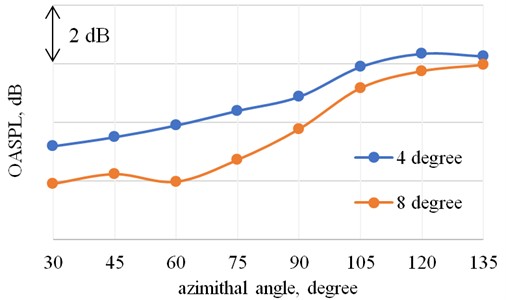
Fig. 12Influence of the angle of pitch on the spectrum of sound pressure levels when the power plant is operating under static conditions (φ= 120°, ne= 5400 rpm)

3.5. Influence of the propeller diameter
One of the important parameters affecting the propeller noise is its diameter [55-57]. The condition for a correct comparison of two propellers in the context of the influence of various parameters on noise is the condition of constant thrust. With an increase in the diameter of the propeller at a constant speed, an increase in both thrust and the circumferential speed of the propeller should be expected, which leads to an increase in noise levels. At the same time, with an increase in the diameter of the propeller and a compensating decrease in the propeller speed, in order to maintain the condition of constant thrust, a reduction in propeller noise should be expected due to the distribution of aerodynamic load over a larger area.
At the same time, when the power plant includes fixed-pitch propellers, an indirect effect of the diameter of the propeller on the overall noise from the PP should be expected due to the influence of the diameter of the propeller on the load on the engine. The higher the load, the noisier the engine will be at the same engine speed. Note that the comparison is made for propellers with diameters () of 0.486 and 0.508 m. A propeller of a smaller (by 6 %) diameter is obtained by truncating the tip of a propeller of a larger diameter.
The radiation patterns of the total noise radiated for propellers of two diameters, measured when the PP is operating under static conditions, are shown in Fig. 13. With an increase in the diameter of the propeller, provided that the engine speed is constant, noise levels increase throughout the studied range of azimuth angles by 1.3 dB in the direction of 135°. There is no effect on the nature of the directivity pattern of total noise radiation.
Fig. 13The effect of the propeller diameter on the directivity patterns of the total noise radiation (25-10000 Hz) (ne= 4860 rpm, without wing)
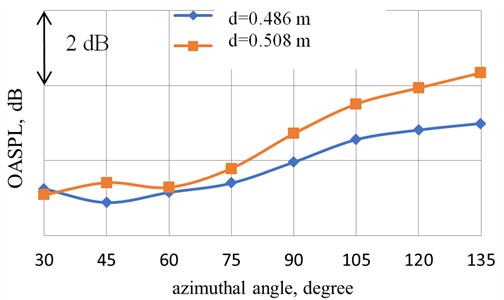
For the direction of the maximum of the radiation pattern of the total radiation, Fig. 14 shows a comparison of the spectrum of sound pressure levels in the 1/3-octave frequency bands. It can be seen that the sound pressure level of the 4th tone in the spectrum, including the 1st tone of propeller noise, increases by 2 dB with an increasing diameter. An increase in the diameter of the propeller leads to an increase in the load on the engine, which leads to an increase in the sound pressure levels of the tones of the engine noise, while the greatest effect (6 dB) is observed at the frequency of the second tone in the spectrum.
The resulting effect of reducing the propeller noise with a decrease in diameter at a constant rotation speed is consistent with the semiempirical theory of propeller noise [51], and the obtained directional patterns of the first harmonic of the noise of the propeller rotation under static conditions (Fig. 13) are consistent with experimental data previously obtained by the authors for other propeller aircraft [11, 12] and the results of numerical studies by other authors [13, 25].
Fig. 14The effect of the propeller diameter on the spectrum of sound pressure levels (φ= 135°, ne= 4860 rpm, without wing)
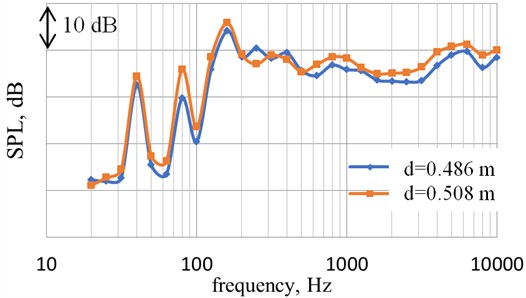
3.6. Influence of the bonnet vibrations
It is known that one of the main ways to reduce the structure-borne noise of the engine is the installation of various bonnets [58, 59]. The Ptero-G0 engine is enclosed in the bonnet, while in these laboratory tests it was possible to assess the effect of the bonnet on the noise of the aircraft. It was expected that the influence of the bonnet would be insignificant, and the configurations of the UAV without wing were compared only when the PP was operating under static conditions.
The directivity patterns of the total noise radiation of the PP are shown in Fig. 15. It can be seen that installing the bonnet on the engine leads to an increase in the overall noise levels by 1.2-2.5 dB in the range of azimuthal angles of 45-135°. In the direction of 30°, the engine cowling leads to a decrease in the overall sound pressure levels by 4.7 dB.
Fig. 15The effect of bonnet on the directivity pattern of the total noise radiation (25-10000 Hz) for a reduced PP power condition (ne= 4470 rpm)
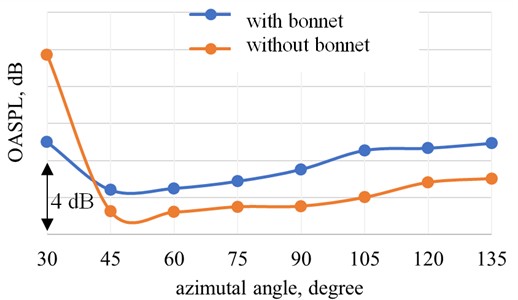
The effect of the bonnet on the spectrum of the sound pressure levels of the PP in the 1/3-octave frequency bands for the direction of radiation at 120° is considered in Fig. 16. It can be seen that installing the bonnet leads to an increase in the levels of the tonal components of the PP noise up to a frequency of 2000 Hz. On separate tones, the increase in sound pressure levels is 10 dB. In fact, vibrations of the engine bonnet at frequencies that are multiples of the frequency of flashes in the cylinder lead to an increase in the overall noise level of the UAV power plant.
Fig. 16The effect of bonnet on the spectrum of sound pressure levels (φ= 120°, ne= 4470 rpm)
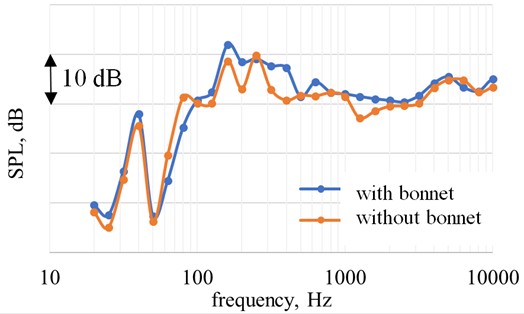
4. Conclusions
Based on the performed parametric study of a Ptero-G0 UAV, the following results were obtained.
The dominant source of the PP noise is an internal combustion engine with a low-efficiency exhaust muffler. The radiation of the propeller dominates at the frequency of the 4th tone in the spectrum.
Under static conditions, an increase in the angle of pitch of the UAV from 4° to 8° leads to a decrease in the overall sound pressure level by up to 2 dB in the direction of 60°.
An increase in the diameter of the propeller at a constant speed leads to an increase in the circumferential speed of the propeller and thrust, as well as the load on the engine. As a result, the intensity of the tonal components of the propeller and engine noise increases. A slight decrease in diameter (by 6 %) led to a decrease in the total noise level by 1.3 dB in the entire studied range of azimuth angles without an effect on the nature of the directivity pattern. Such a design solution can be effective in reducing the degree of acoustic signature of fixed-wing propeller aircraft.
The conclusion of the engine in the bonnet without a vibration and sound insulation system leads to an increase in the overall sound pressure levels by up to 2.5 dB in the entire range of radiation propagation directions under consideration, with the exception of the 30° direction, where most likely, in the absence of a bonnet, the structure-borne noise of the piston engine dominates.
Tests of the UAV have shown that in the absence of a gearbox, it is quite difficult to separate the noise of the propeller and the piston engine when testing full-scale aircraft. This problem is solved in a full-scale experiment under certain assumptions. In order to separate sources at the same frequency, it is advisable to carry out studies using other methods of loading the engine (hydro, electric brakes, etc.) or using an electric motor as a propeller drive.
For the specific UAV under study with a low-efficiency exhaust muffler, the flight mode and, as a consequence, the power plant operating mode will have the greatest impact on the community noise level. Parameters such as bonnet vibrations and propeller diameter should be taken into account when designing similar small-sized UAVs. The pitch angle of the UAV should be taken into account when assessing the community noise of such UAVs when considering various modes (climb, cruise flight), where the influence of this parameter will manifest itself.
The presented results can be used to validate computational methods for estimating the noise of a propeller and a piston engine.
References
-
M. A. Pogosyan and P. A. Moshkov, “Modern problems of aeroacoustics of propeller-driven fixed-wing aircrafts,” Journal of Dynamics and Vibroacoustics, Vol. 9, No. 1, pp. 6–15, May 2023, https://doi.org/10.18287/2409-4579-2023-9-1-6-15
-
B. Harvey and S. O. ’Young, “Acoustic detection of a fixed-wing UAV,” Drones, Vol. 2, No. 1, Jan. 2018, https://doi.org/10.3390/drones2010004
-
P. A. Moshkov, V. F. Samokhin, and A. A. Yakovlev, “Selection of an audibility criterion for propeller driven unmanned aerial vehicle,” Russian Aeronautics, Vol. 61, No. 2, pp. 149–155, Jan. 2019, https://doi.org/10.3103/s1068799818020010
-
X. Xin, F. Pan, Y. Wang, and X. Feng, “Multi-UAV cooperative localization using adaptive Wasserstein filter with distance-constrained bare bones self-recovery particles,” Drones, Vol. 8, No. 6, p. 234, May 2024, https://doi.org/10.3390/drones8060234
-
S. Wu, Y. Zheng, K. Ye, H. Cao, X. Zhang, and H. Sun, “Sound source localization for unmanned aerial vehicles in low signal-to-noise ratio environments,” Remote Sensing, Vol. 16, No. 11, p. 1847, May 2024, https://doi.org/10.3390/rs16111847
-
A. Filippone and A. Harwood, “Flyover noise measurements and predictions of commercial airplanes,” Journal of Aircraft, Vol. 53, No. 2, pp. 396–405, Mar. 2016, https://doi.org/10.2514/1.c033370
-
J. L. Thomas and R. J. Hansman, “Framework for analyzing aircraft community noise impacts of advanced operational flight procedures,” Journal of Aircraft, Vol. 56, pp. 1407–1417, 2019.
-
M. Arntzen, S. A. Rizzi, H. G. Visser, and D. G. Simons, “Framework for simulating aircraft flyover noise through nonstandard atmospheres,” Journal of Aircraft, Vol. 51, pp. 956–966, 2014.
-
L. Bertsch et al., “Comparative assessment of aircraft system noise simulation tools,” Journal of Aircraft, Vol. 58, pp. 867–884, 2021.
-
A. Filippone, “Aircraft noise prediction,” Progress in Aerospace Sciences, Vol. 68, pp. 27–63, 2014.
-
M. A. Pogosyan, S. F. Timushev, P. A. Moshkov, and A. A. Yakovlev, “Simulation of isolated propeller noise using acoustic-vortex method,” Supercomputing Frontiers and Innovations, Vol. 10, No. 1, pp. 21–30, Mar. 2023, https://doi.org/10.14529/jsfi230102
-
P. Moshkov, “Study of the propellers noise of light aircraft under static conditions,” in 2022 International Conference on Dynamics and Vibroacoustics of Machines (DVM), Sep. 2022, https://doi.org/10.1109/dvm55487.2022.9930902
-
W. Dobrzynski, B. Gehlhar, W. Dobrzynski, and B. Gehlhar, “The noise from piston engine driven propellers on general aviation airplanes,” in 3rd AIAA/CEAS Aeroacoustics Conference, May 1997, https://doi.org/10.2514/6.1997-1708
-
P. Moshkov, “Study of an aviation opposed piston engine noise,” Aerospace Systems, Vol. 5, No. 4, pp. 607–613, Jul. 2022, https://doi.org/10.1007/s42401-022-00157-7
-
P. Moshkov and E. Toropylina, “Assessment of the use of electric power plants on the propeller-driven aircraft noise,” Aerospace Systems, Vol. 6, No. 1, pp. 101–106, Oct. 2022, https://doi.org/10.1007/s42401-022-00167-5
-
W. Dobrzynski, “Almost 40 years of airframe noise research: what did we achieve?,” Journal of Aircraft, Vol. 47, No. 2, pp. 353–367, Mar. 2010, https://doi.org/10.2514/1.44457
-
P. A. Moshkov, “Study of the wing noise of an unmanned aerial vehicle,” Russian Aeronautics, Vol. 64, No. 2, pp. 240–247, Sep. 2021, https://doi.org/10.3103/s1068799821020100
-
N. Molin, “Airframe noise modeling and prediction,” CEAS Aeronautical Journal, Vol. 10, No. 1, pp. 11–29, Mar. 2019, https://doi.org/10.1007/s13272-019-00375-4
-
S. L. Denisov, N. N. Ostrikov, and V. Y. Granich, “Problems of aviation power plants noise reduction by means of shielding effect,” Acoustical Physics, Vol. 67, pp. 293–297, 2021.
-
V. A. Titarev, G. A. Faranosov, S. A. Chernyshev, and A. S. Batrakov, “Numerical modeling of the influence of the relative positions of a propeller and pylon on turboprop aircraft noise,” Acoustical Physics, Vol. 64, pp. 760–773, 2018.
-
Z.-H. Wang, S. W. Rienstra, C.-X. Bi, and B. Koren, “An accurate and efficient computational method for time-domain aeroacoustic scattering,” Journal of Computational Physics, Vol. 412, p. 109442, Jul. 2020, https://doi.org/10.1016/j.jcp.2020.109442
-
P. Moshkov, “Ambient noise: problem and study in the framework of UAV aeroacoustics,” Akustika, Vol. 41, pp. 16–21, 2021.
-
P. Moshkov and M. Pogosyan, “The concept of acoustic design of propeller-driven fixed-wing aircrafts,” in E3S Web of Conferences, Vol. 446, p. 01006, Nov. 2023, https://doi.org/10.1051/e3sconf/202344601006
-
P. Candeloro, D. Ragni, and T. Pagliaroli, “Small-scale rotor aeroacoustics for drone propulsion: a review of noise sources and control strategies,” Fluids, Vol. 7, No. 8, p. 279, Aug. 2022, https://doi.org/10.3390/fluids7080279
-
D. Xue, Q. Yan, Z. Li, and K. Wei, “Multidisciplinary optimization design of low-noise propellers,” Aerospace, Vol. 10, No. 3, p. 254, Mar. 2023, https://doi.org/10.3390/aerospace10030254
-
W. Klimczyk and A. Sieradzki, “RANS-based aeroacoustic global sensitivity study and optimization of UAV propellers,” Aerospace, Vol. 10, No. 3, p. 306, Mar. 2023, https://doi.org/10.3390/aerospace10030306
-
G. Romani, E. Grande, F. Avallone, D. Ragni, and D. Casalino, “Performance and noise prediction of low-Reynolds number propellers using the Lattice-Boltzmann method,” Aerospace Science and Technology, Vol. 125, p. 107086, Jun. 2022, https://doi.org/10.1016/j.ast.2021.107086
-
K. Baskaran, N. S. Jamaluddin, A. Celik, D. Rezgui, and M. Azarpeyvand, “Effects of number of blades on propeller noise,” Journal of Sound and Vibration, Vol. 572, p. 118176, Mar. 2024, https://doi.org/10.1016/j.jsv.2023.118176
-
D. C. Akiwate, P. Joseph, A. Parry, and C. Paruchuri, “On the balance between the tonal and broadband noise of isolated propellers,” International Journal of Aeroacoustics, Vol. 23, No. 1-2, pp. 122–153, Jan. 2024, https://doi.org/10.1177/1475472x231225631
-
G. Barakos and C. Johnson, “Acoustic comparison of propellers,” International Journal of Aeroacoustics, Vol. 15, No. 6-7, pp. 575–594, Jul. 2016, https://doi.org/10.1177/1475472x16659214
-
D. P. Lockard, “Airframe noise predictions using the Ffowcs Williams-Hawkings equation,” International Journal of Aeroacoustics, Vol. 21, No. 5-7, pp. 476–500, Jul. 2022, https://doi.org/10.1177/1475472x221107366
-
R. N. Hota and M. L. Munjal, “Approximate empirical expressions for the aeroacoustic source strength level of the exhaust system of compression ignition engines,” International Journal of Aeroacoustics, Vol. 7, No. 3-4, pp. 349–371, Sep. 2008, https://doi.org/10.1260/1475-472x.7.3.349
-
D. C. Amargianitakis et al., “Measurement and modelling of noise-power-distance curves of a fixed-wing UAV,” in 28th AIAA/CEAS Aeroacoustics 2022 Conference, Jun. 2022, https://doi.org/10.2514/6.2022-3037
-
H. Xu, D. Kong, Y. Qian, and X. Tang, “Motor noise reduction of unmanned aerial vehicles,” Applied Acoustics, Vol. 198, p. 108979, Sep. 2022, https://doi.org/10.1016/j.apacoust.2022.108979
-
S. Zuo and Q. Mao, “A method for identifying the noise characteristics of an electric motor system based on tests conducted under distinct operating conditions,” WCX SAE World Congress Experience, Apr. 2024, https://doi.org/10.4271/2024-01-2334
-
K. Cussen, S. Garruccio, and J. Kennedy, “UAV noise emission-a combined experimental and numerical assessment,” Acoustics, Vol. 4, No. 2, pp. 297–312, Mar. 2022, https://doi.org/10.3390/acoustics4020018
-
A. Taghipour, R. Pieren, and B. Schäffer, “Short-term annoyance reactions to civil helicopter and propeller-driven aircraft noise: A laboratory experiment,” The Journal of the Acoustical Society of America, Vol. 145, No. 2, pp. 956–967, Feb. 2019, https://doi.org/10.1121/1.5090500
-
B. Schäffer, R. Pieren, K. Heutschi, J. M. Wunderli, and S. Becker, “Drone noise emission characteristics and noise effects on humans-a systematic review,” International Journal of Environmental Research and Public Health, Vol. 18, No. 11, p. 5940, Jun. 2021, https://doi.org/10.3390/ijerph18115940
-
D. Vittal-Shenoy, R. Gojon, T. Jardin, and M. C. Jacob, “Angle-of-attack and Mach number effects on the aeroacoustics of an SD7003 airfoil at Reynolds number 60,000,” International Journal of Aeroacoustics, Vol. 22, No. 1-2, pp. 131–152, Jan. 2023, https://doi.org/10.1177/1475472x221150173
-
P. T. Soderman, F. Kafyeke, J. Boudreau, N. J. Burnside, S. M. Jaeger, and R. Chandrasekharan, “Airframe noise study of a bombardier CRJ-700 aircraft model in the NASA Ames 7-by 10-foot wind tunnel,” International Journal of Aeroacoustics, Vol. 3, No. 1, pp. 1–42, Jan. 2004, https://doi.org/10.1260/147547204323022248
-
P. A. Moshkov, “Acoustic characteristics of aero internal combustion engines,” in Journal of Physics: Conference Series, Vol. 1891, No. 1, p. 012006, May 2021, https://doi.org/10.1088/1742-6596/1891/1/012006
-
P. Moshkov, N. Ostrikov, V. Samokhin, and A. Valiev, “Study of Ptero-G0 UAV noise with level flight conditions,” in 25th AIAA/CEAS Aeroacoustics Conference, May 2019, https://doi.org/10.2514/6.2019-2514
-
I. V. Belyaev, A. V. Valiev, P. A. Moshkov, and N. N. Ostrikov, “Studying the PTERO-G0 unmanned flying vehicles acoustic characteristics in AK-2 unechoic chamber,” MAI Aerospace Journal, Vol. 24, pp. 52–62, 2017.
-
P. A. Moshkov and A. A. Yakovlev, “Separation of propeller and piston engine noise based on the results of light propeller-driven aircraft tests under static condition,” in VII International Conference Safety Problems of Civil Engineering Critical Infrastructures (SPCECI2021), Vol. 2701, p. 020050, Jan. 2023, https://doi.org/10.1063/5.0125051
-
P. Moshkov and S. Timushev, “Evaluation of the audibility boundaries of multirotor systems of different configurations,” in E3S Web of Conferences, Vol. 446, p. 01007, Nov. 2023, https://doi.org/10.1051/e3sconf/202344601007
-
B. Chen, A. Yakovlev, and P. Moshkov, “Prediction noise of propeller on wing for distributed electric propulsion configuration,” Aerospace Systems, Vol. 6, No. 3, pp. 501–507, Mar. 2023, https://doi.org/10.1007/s42401-023-00194-w
-
P. Moshkov, “Study of the influence of in-flight conditions on the light propeller-driven aircraft noise,” Aerospace Systems, Vol. 5, No. 1, pp. 131–140, Jan. 2022, https://doi.org/10.1007/s42401-021-00127-5
-
B. Chen, A. A. Yakovlev, and P. A. Moshkov, “Fast prediction method of aircraft noise with distributed propulsion in the far field,” in Journal of Physics: Conference Series, Vol. 1925, No. 1, p. 012007, May 2021, https://doi.org/10.1088/1742-6596/1925/1/012007
-
P. A. Moshkov, V. F. Samokhin, and A. A. Yakovlev, “Study of the noise sources of an UAV with a two-stroke engine and shrouded propeller,” in Journal of Physics: Conference Series, Vol. 1925, No. 1, p. 012001, May 2021, https://doi.org/10.1088/1742-6596/1925/1/012001
-
P. Moshkov, V. Samokhin, and A. Yakovlev, “Engine-propeller power plant aircraft community noise reduction key methods,” International Conference on Electrical, Electronics, Materials and Applied Science, Vol. 1952, p. 020059, Jan. 2018, https://doi.org/10.1063/1.5032021
-
P. A. Moshkov and V. F. Samokhin, “Integral model of noise of an engine-propeller power plant,” Journal of Engineering Physics and Thermophysics, Vol. 91, No. 2, pp. 332–338, May 2018, https://doi.org/10.1007/s10891-018-1753-8
-
I. V. Belyaev, M. Y. Zaytsev, V. F. Kopiev, and I. V. Pankratov, “Experimental research on noise reduction for realistic landing gear geometries,” Acoustical Physics, Vol. 65, No. 3, pp. 297–306, Jun. 2019, https://doi.org/10.1134/s1063771019030011
-
D. B. Hanson, “Sound from a propeller at angle of attack: a new theoretical viewpoint,” Proceedings of the Royal Society of London. Series A: Mathematical and Physical Sciences, Vol. 449, No. 1936, pp. 315–328, May 1995, https://doi.org/10.1098/rspa.1995.0046
-
J. J. Kelly and L. C. Nguyen, “Influence of shaft angle of attack on sound radiation by subsonic propellers,” Journal of Aircraft, Vol. 34, No. 4, pp. 539–544, Jul. 1997, https://doi.org/10.2514/2.2206
-
Z. Huang, H. Yao, A. Lundbladh, and L. Davidson, “Low-noise propeller design for quiet electric aircraft,” in AIAA Aviation 2020 Forum, Jun. 2020, https://doi.org/10.2514/6.2020-2596
-
M. T. Kotwicz Herniczek, D. Feszty, S.-A. Meslioui, J. Park, and F. Nitzsche, “Evaluation of acoustic frequency methods for the prediction of propeller noise,” AIAA Journal, Vol. 57, No. 6, pp. 2465–2478, Jun. 2019, https://doi.org/10.2514/1.j056658
-
Y. Liu, Y. Wang, S. Xiang, and M. Wang, “Noise characteristics of propellers with different blade tips for electric aircraft,” Hangkong Xuebao, Vol. 42, p. 62456, 2021, https://doi.org/10.7527/s1000-6893.2020.24567
-
A. L. Yakovenko, M. G. Shatrov, A. O. Glazkov, S. M. Kuznetsov, I. V. Alekseev, and S. N. Bogdanov, “Modern approaches for modeling of structure-borne noise of the internal combustion engine,” in International Journal of Online and Biomedical Engineering (iJOE), Vol. 16, No. 7, pp. 105–113, Jun. 2020, https://doi.org/10.3991/ijoe.v16i07.14547
-
N. D. Chaynov, V. A. Markov, and A. A. Savastenko, “Structural noise and acoustic characteristics improvement of transport power plants,” in IOP Conference Series: Materials Science and Engineering, Vol. 327, p. 022069, Apr. 2018, https://doi.org/https://doi.org/10.1088/1757-899x/327/2/022069
About this article
The authors have not disclosed any funding.
The authors express their gratitude to the General Director of AFM-Servers LLC, Valiev Amir, for his assistance in organizing and conducting acoustic tests of a Ptero-G0 UAV
The datasets generated during and/or analyzed during the current study are available from the corresponding author on reasonable request.
Petr Moshkov: data curation, formal analysis, investigation, writing-original draft preparation writing-review and editing. Mikhail Pogosyan: conceptualization, writing-original draft preparation, writing-review and editing.
The authors declare that they have no conflict of interest.
